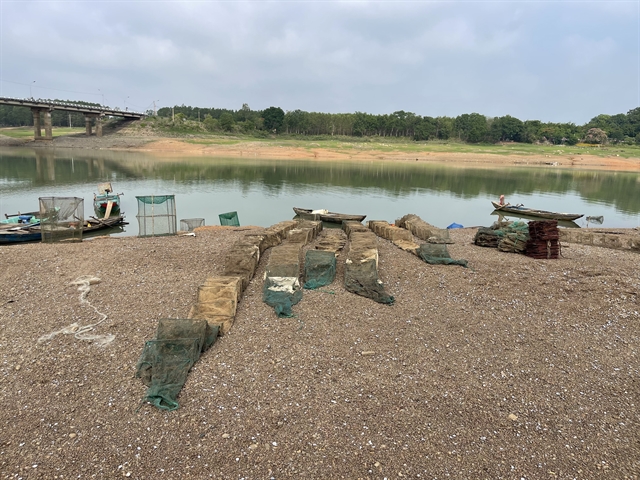 Environment
Environment

 |
| Trị An hydro-power reservoir in Đồng Nai Province is drying up. Fishermen's fishing instruments are left unused on the banks. — VNA/VNS Photo |
ĐỒNG NAI — Trị An hydro-power reservoir in the southern province of Đồng Nai is facing a severe drought, according to Trị An Hydropower Company.
Water levels have dropped to the lowest in 13 years.
The water level of Trị An reservoir on May 12 was measured at 51m, which is only 0.5m from the "dead water level", while the normal water level of the lake is 62m, the company said.
In the rainy season, the reservoir is full of water. But now, the water has receded, making the whole reservoir bed dry and inert.
The situation has caused difficulties to caged-fish farming and fishing activities of the people near the reservoir.
Trị An Reservoir was formed from the Trị An hydro-electric project located in the four districts of Vĩnh Cửu, Trảng Bom, Thống Nhất and Định Quán, about 70 km from HCM City.
There are 76 islets in the reservoir.
With an area of 32,000 hectares, the reservoir is where thousands of households make a living by raising caged-fish and fishing.
Although there has been rain at the beginning of the season, the amount of water in the reservoir has not changed much, which has greatly affected the management and protection of the reservoir.
Nguyễn Văn Nghĩa, a resident in Mã Đà Commune of Vĩnh Cửu District who has made a living on Trị An Reservoir by fishing for more than 20 years, said that he has never witnessed the reservoir has dried up as this year.
In previous years, at the end of the dry season, the water surface area was still wide and fishermen still had a source of income, but this year, the water receded dramatically and the fish source was no longer available, so the fishermen have faced many difficulties, Nghĩa said.
“Previously, in the dry season, I still caught about 10-20kg of fish every day, earning a stable income,” said Nghĩa.
“But this dry season, the low water level caused many aquatic species to be stranded and die in large quantities so I only caught about 3-7kg of fish per day. My income became precarious,” the fisherman said.
 |
| The receding water of the lake has created cracks like a desert landscape. — VNA/VNS Photo Lê Xuân |
In a caged-fish breeding village in the reservoir, the farmers are also in a difficult situation because the receding water caused many fingerlings to die, pushing many households into debt.
Many fish farming owners had to switch to fishing to earn more income.
Lê Thị Phiên, a caged-fish farming owner in Mã Đà Commune, said that since the Lunar New Year until now, her family's fingerlings have all been damaged due to the receding water, which affected the fish's habitat.
“My family just released 20,000 fingerlings, but most of them died in a few days because of turbid water,” Phiên said.
“The family has lost nearly VNĐ40 million (US$1,700) so far,” Phiên said.
According to the Agriculture Centre of Vĩnh Cửu District, although there have been some heavy rains, the amount of water in the reservoir has increased only slightly.
But with the current situation, it will take a few months for the water to stabilise to release new batches of fish.
The centre said that this year the fish farmers will miss a farming crop that will greatly affect the income of the people.
Nguyễn Văn Phước, head forest ranger of the Đồng Nai Nature and Culture Conservation Park, said that this dry season, the reservoir water level is not only shallower than previous years, but the time that the water has receded has also been longer.
When the water level is low, there will be shallow grounds and crannies on the reservoir bed. Therefore, many people have used prohibited fishing gear to carry out destructive fishing, making it difficult to manage and protect the reservoir, said Phước.
In addition, in the dry season, the semi-submerged land area forms very large alluvial grounds, so people come to camp spontaneously. This activity causes difficulties to the management of the park area, he added. — VNS




